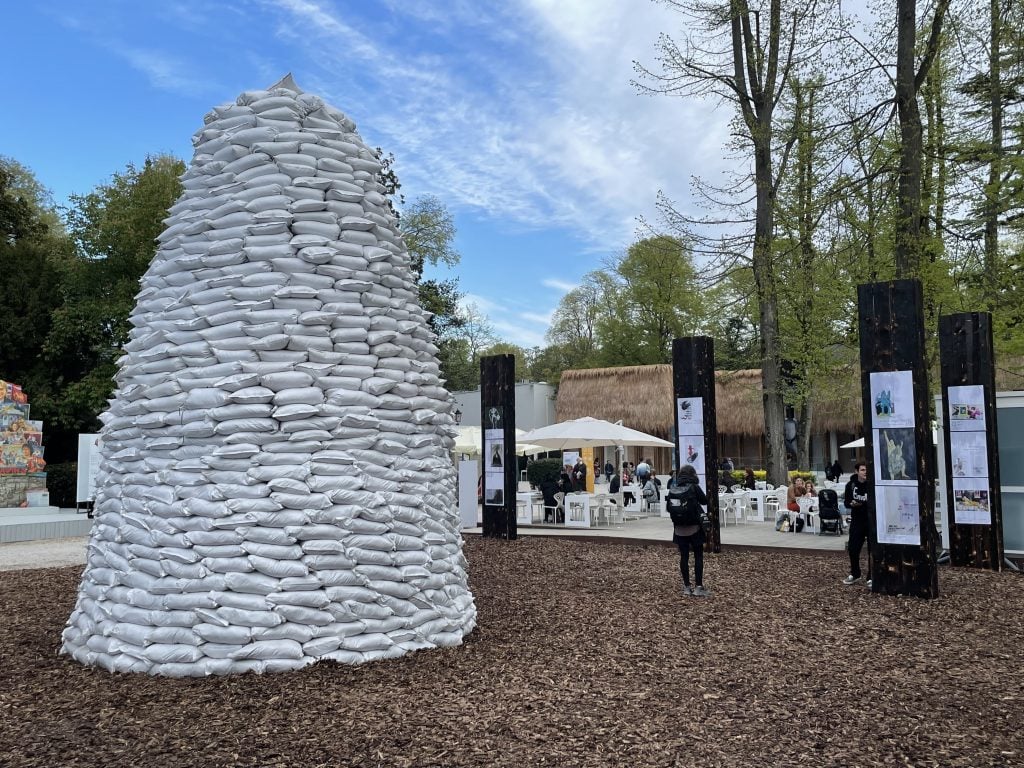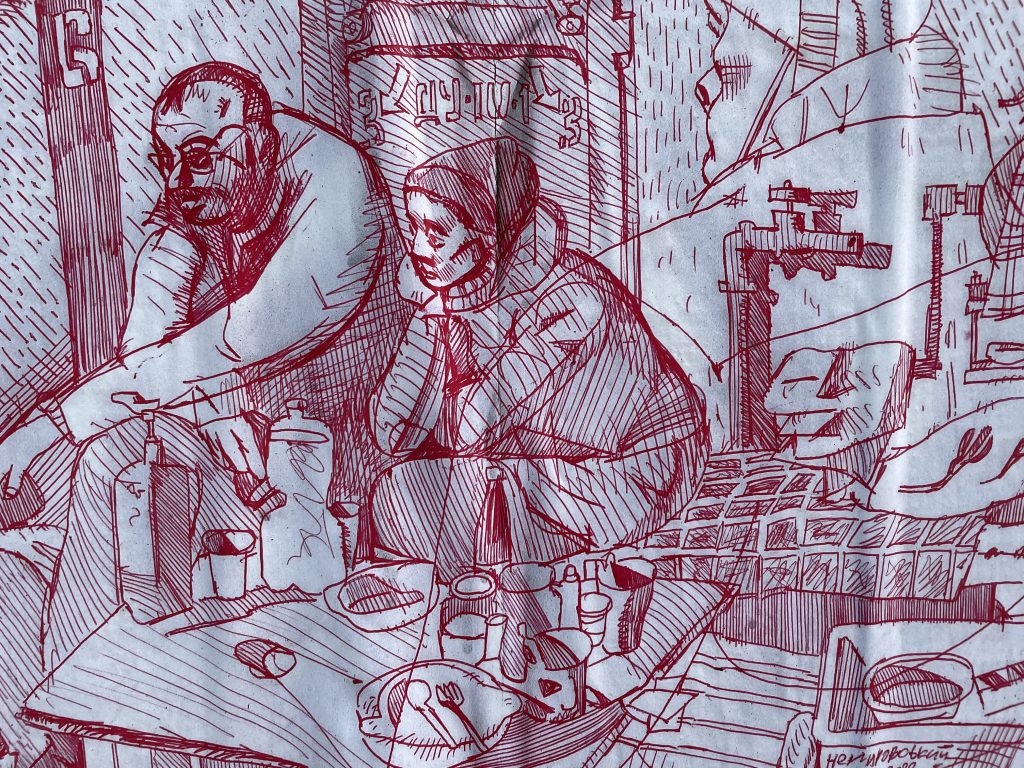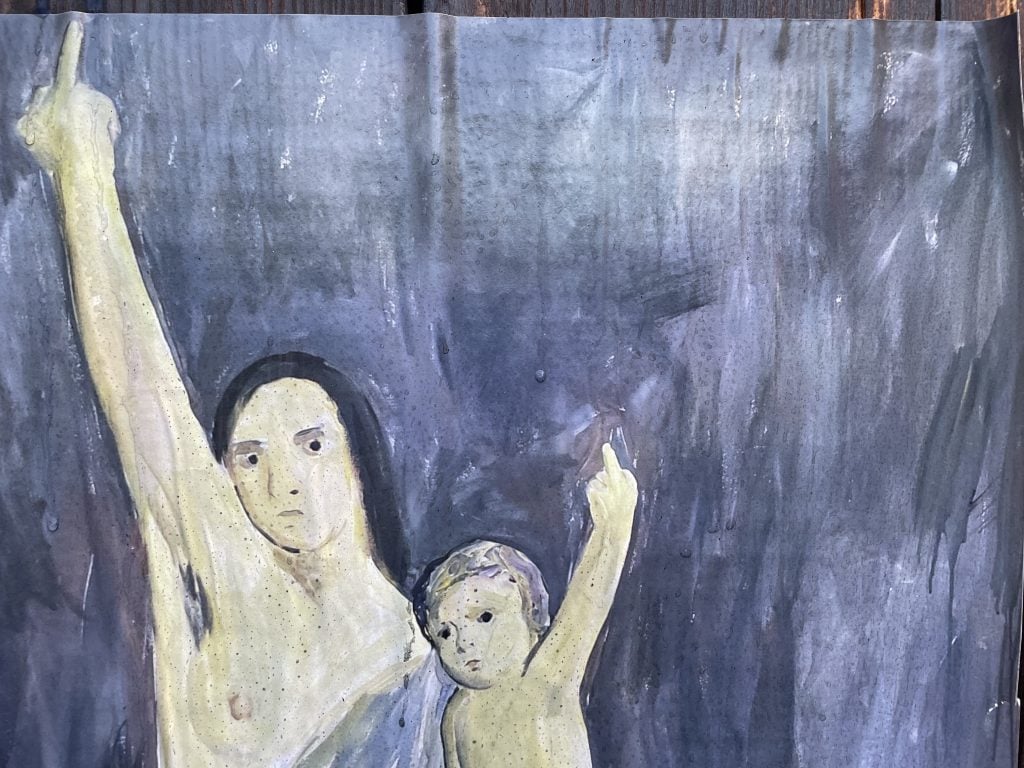Art & Exhibitions
A Last-Minute Addition to the Biennale Is Delivering Artworks Straight From Artists Trapped in Ukraine to Venice
Artworks will be rotated monthly to reflect ongoing artistic production in wartime.

Artworks will be rotated monthly to reflect ongoing artistic production in wartime.

Kate Brown

Never mind the packing materials still stacked up on the side of the hastily erected Piazza Ucraina, the latest addition to the Giardini in Venice. Nor the few small typos on the posters that have been hung, or that the work was only half-installed on the first morning of the biennale preview: Incredibly, this piazza has come together in less than a week, with its artists and curators working overtime and ad-hoc as they struggle to forge ahead amid a ravaging war at home.
The eleventh-hour installation was organized by the curators of the Ukrainian pavilion—Borys Filonenko, Lizaveta German, and Maria Lanko—at the invitation of the Venice Biennale and its main curator, Cecilia Alemani, as a way to address the dire conditions in Ukraine. Set among the nation-state pavilions that have stood in the Giardini for decades, it is a powerful statement in the face of the ongoing invasion by the Russian army.
The piazza itself is stark: populated with benches for rest, in its very center stands a tower of sandbags, reminiscent of those images that have circulated on the internet in recent weeks, showing ordinary Ukrainian citizens sandbagging their art, historic memorials, and public sculptures in hopes they survive the Russian bombings. There are pillars of wood, burnt black, on which hang A1 posters displaying artworks made by artists during the past months, since the invasion began in February. The posters, which are incredible testimonials and diaries of life during war, will remain on view throughout the biennale, the images changing monthly.
“Some document personal experience and others are trying to give a voice to those who do not have one right now,” Filonenko told Artnet News. “Many of these artworks have been made in shelters.” The contribution of Daniel Nemyrovski, who is based in the besieged city of Mariupol, is one such case—the curator said that they had lost contact with him for weeks. But Filonenko added that there have been “miraculous” moments of internet connection, during which high-res images could be sent and information about people’s well-being exchanged.

Daniel Nemyrovski, Sketches from the Shelter on Semashka Street in Mariupol – The Young Family. Made between March 12 and 20, 2022. Photo: Artnet News.
Nemyrovski’s pair of drawings in red ink were made in a bomb shelter between March 12 and 20. The poignant sketches depict several people who had been sheltering there for the three weeks. They stare blankly, wrapped in thick jackets and blankets. In another, a group is depicted in a discussion under a dangling lightbulb.
On another pillar, a watercolor by Lviv-based artist Kinder Album shows a naked woman tied up in the snow, encircled by Russian soldiers.
Though artworks are typically dated by year, these posters are dated by the day. The situation in Ukraine is changing so rapidly, each week denotes a different phase of the war. Only one work was made before the full-scale war began on February 24: an acrylic on paper by Kateryna Lysovenko, shows a mother and child lifting their middle fingers in triumph. It was made two days before the latest onslaught began, and Filonenko said it is a reminder that this conflict is not new—Russia first invaded Ukraine back in 2014, and violence has not stopped since that time.
“We are trying to show as much as we can in the time that we have,” Filonenko said. He and his team have been working a double shift, while also organizing the national pavilion, with works by Pavlo Makov. For the group, the decision to come to Venice and leave their embattled country behind was not a simple one, “but it is our duty to defend the cultural front, so to speak,” Filonenko said. “This piazza is our attempt to show how many fantastic artists we have in Ukraine who should be better known, and who are very important to us.”

Kateryna Lysovenko, Untitled. Made February 22, 2022. Photo: Artnet News.
A few steps away, the Russian pavilion is hushed and quiet, the doors locked. The organizers canceled their participation in the early days of the invasion. In those first weeks, it seemed unlikely that the Ukrainian pavilion would even make it to Venice, but the artist Makov and the curators managed the complicated journey. In the last days, Makov’s neighborhood in Kharkiv has faced heavy shelling. It is not clear as of writing whether his home is still standing.
Another collateral event was added to the bill at the last minute, organized by the PinchukArtCenter and the Victor Pinchuk Foundation at the Scuola Grade della Misericordia, replacing what was planned to be a display of the nominees for the Pinchuk Foundation’s Future Generation Art Prize. Ukrainian artists Nikita Kadan, Yevgenia Belorusets, and Lesia Khomenko have created new pieces, which are presented alongside historical works by Stefan Medytsky and Maria Priymachenko; the latter is also featured the main exhibition, “The Milk of Dreams,“ curated by Alemani. A museum of her celebrated early 20th-century folk art was destroyed in early March.
Somewhat confusingly, a second chapter of the group show includes works by famous artists responding to the war, including Olafur Eliasson, Damien Hirst, and Marina Abramović, among others. Ukrainian president Volodymyr Zelensky also submitted an image for the show.
Another collateral event, at the Spiazzi cultural center in the Castello district, features a solo presentation by the Ukrainian artist Zinaida, who came to Venice for a site visit in early April and has not been able to return home. It was unclear until last week whether the work would even arrive to Venice in time.
The Ukrainian pavilion and piazza co-curator Filoneko said responses from Europeans in Venice have so far not been always easy or empathetic. “Many here are not involved in this war,” he said. “We have been getting questions full of Russian propaganda. Someone asked me recently if I was a nationalist.”
He hopes that the Piazza Ucraina will help to bring about more meaningful responses from the art world and the public. Meanwhile, he continues to check his phone hourly to make sure friends, family, and fellow artists are okay. Filoneko adds that the cost of war is something felt by the whole country: “There is not work-life balance for us Ukrainian artists. It is just a work-war balance.”